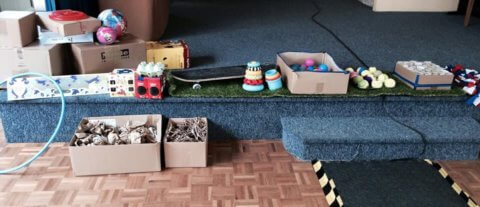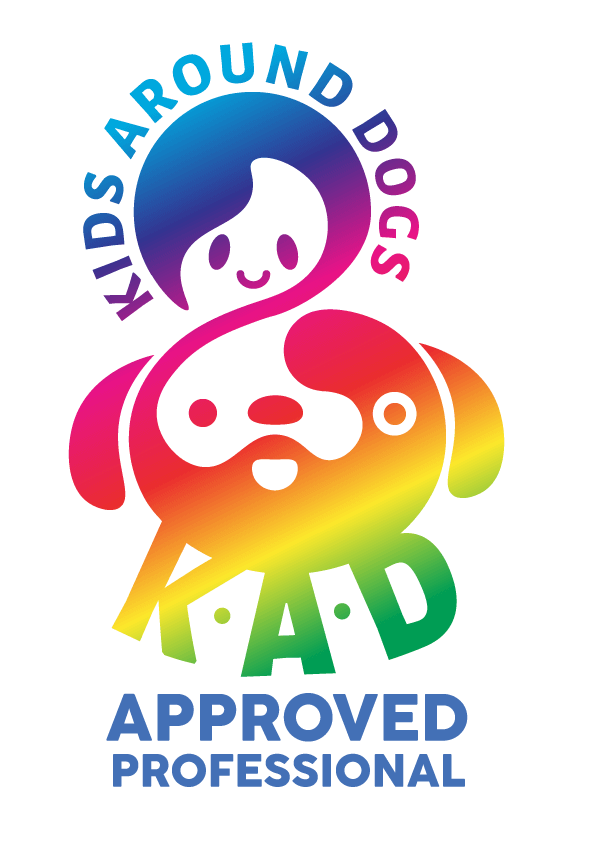In 2010 my little book was published, designed as a quick-read for owners to understand the importance of play and to help them get started on some easy games and tricks to teach their dog.
The past few years have been surreal, for example by March 2020 around 20% of the world’s population was in lockdown due to the coronavirus (COVID-19). Undoubtedly throughout this time people have been worried about their loved ones and finances, so it might sound naïve to suggest playing with your dog helps. However, science shows that it really can be a good stress reliever for you and your pet. Playing not only expends excess energy – helpful where restrictions on people’s movements over the many months meant both ourselves and pets have been getting less outdoor time than usual, and playing also increases one-to-one interaction time which can build a stronger bond.
For example, Harber and Sutton (1984) recorded beta-endorphin release occurs in humans during physical exercise such as play and training, creating a natural ‘high’. This has also been observed in problem-solving tasks, where dogs learned to control access to a reward, producing positive affective states (McGowan et al., 2013). In my 2018 study of 342 pre- and post-partum parents, time spent with the dog including playing, grooming and walking had high value and was significantly reduced once the baby arrived, causing many owners to feel guilty. Reduced time spent with the dog was correlated with lower attachment scores, supporting previous studies (Smith, 1983; Voith, 1984).
So while this continues to be a challenging time as COVID-19 and new variants continue to crop up and or weather temperatures impact our dog walks, please look at this as an opportunity for you and any children at home to hone energies into positive play with pets. Below takes inspiration from that little book of mine…
A Sense of Play
All of your dog’s senses are crucial to their enjoyment of games, so let’s take a look at one of these: the sense of smell. Your dog has an incredible nose. The average human has five million hair cells up their nose and can grow 6.5ft of nose hair from each follicle over their lifetime! The average dog has over 300 million and has such an acutely sensitive scenting ability that it can identify smells so diluted that even scientific instruments cannot measure them. To study this, Scott and Fuller (1965) placed untrained beagles, Fox terriers and Scottie dogs in a one-acre field and released a mouse. It took the beagles around a minute to locate the mouse and the terriers 15 minutes. The Scotties never found the mouse and, it is reported, that one even stood on the mouse but failed to notice!
Use your dog’s nose for scent games and get the kids involved.
1. Hunt the Treat
With a handful of treats, take your dog into a room. Have someone gently hold onto your dog while you hide treats around the room. This makes the game easy to start if he has not played this before, as it gives him an idea of where the rewards may be. Once you have finished hiding the treats, let him go and use a cue word such as “Go seek” or “Find it”. If he needs help, lead him to the ones he has missed. As your dog starts to learn the cue means there is an opportunity to seek out a hidden treat, make the game harder by getting your dog to sit and have his back turned away from you as you hide the rewards, or in a different room altogether. This game tests his scenting ability, memory and spatial awareness.
2. Box hides
Using the same cue as above for seeking out food rewards, collect all those Amazon boxes that are coming to you right now and use them for games. Start off with a shoe-sized box and make holes into the lid. Place a highly scented treat in the box and then use your cue word (e.g.) “Find it” and let your dog begin the search. Praise him as he finds the treat. Start off in a room with no distractions and just the one box, then you can increase the level of challenge by having several boxes scattered around but not all containing treats so your dog has to use his nose to make those hidden finds!
3. Food circuits
A great way to combine your dog’s chase instinct and scenting ability as a reward, as well as reinforce recall is via the food circuits game. Get yourself a handful of treats and ensure they are of a big enough size that your dog can spot them in the blades of grass if you are in your garden. Stand opposite your dog and call him to you holding out your food treat. As your dog comes to you, draw him around to your side, behind you and then to the other side. For example, call and lure from your right-hand side and bring him behind you then out to your left-hand side. This means your dog is following the food in your hand the whole time. As you bring your dog behind you, pass that treat from your original luring hand (e.g. right hand into your left hand) to the other. Think of how you would pass a basketball. Once the dog has come around to your other side, bowl the food outwards – just a short distance such as a metre to start, to make it easier for him to win. Your dog will then chase after the food. When he gets to the food, praise him and let him eat it, then recall back to you holding out another treat in your hand, and repeat as above. As your dog starts to get the idea of the game, you can throw out the food in all directions to make this less predictable and increase your throwing distance so he has further to scent and then run back to you. See video link below for an example of how to introduce the game.
4. Smelly trees and things
While searching out food hides in boxes or along the ground can be great fun for our dogs, we can create more interest and build confidence where hides are presented in more unusual places and at different heights. Trainer Morag Heirs refers to “cheese trees” which is a great way to describe how you can get your dog used to scenting out particular smells such as cheddar cheese, that is swiped along and up tree trunks, branches, along benches and so on. This teaches your dog to discriminate that particular scent across a range of ‘things’ and in a range of environments. Heirs describes scent work as creating “anticipatory excitement around an appetitive behaviour”. In other words, your dog gets his kicks from the search of the food because he knows it’s going to lead to some good nosh. It’s a bit like the excitement you might see from a child waiting outside Disneyland’s gates because they know what lays ahead is going to be awesome!
5. It’s a knock-out
Grab all those empty water and juice bottles that you have collected whilst at home and instead of putting them in your recycle bin, you can use them for a scent game. Ensure they are all washed out and have no bottle tops on them. Place in some of the bottles some nice smelly treats. Have the bottles lined up in different patterns – think skittles – so they could be in a square, or a triangle shape, you could have them all in a row – whatever takes your fancy. Have your dog at the ready and waiting. Once you have completed your set-up, use your cue to “Find it” and release your dog. Similarly to the box hides game, this can build confidence with dogs that are more sensitive to novel items and sounds as you are pairing these light weighted bottle items which they can knock over with food. If your dog enjoys this game and is confident with the noise and sight of falling items around him, you can then up the game. This means using differing household items such as saucepans, plant pots, paddling pools filled with balls, plastic cups, and treats hidden under tennis balls placed in baking trays – all to encourage him to jump on, in and over things to scent out the hides. See images from our Playing With Your Dog workshop based on my book, as inspiration.
A note about food
It’s important that when you are using food as part of your game playing that you use this smartly. Why not split your dog’s daily allowance so it can be used for his training, playing and for food puzzle toys, then the remainder for the food bowl. Using food in this way reduces the risk of weight gain and maximises opportunities to reinforce your dog for desirable behaviour.
Have fun with your dog and we’d love you to post pictures of you playing with your dog on our Facebook page.
References
Grice, H. (2010) Playing With Your Dog. Indiana: Xlibris.
Harber, V.J., and Sutton, J.R. (1984) ‘Endorphins and exercise.’ Sports Med. 1(2) pp.154-71.
McGowan, R.T.S., Rehn, T., Norling, Y. and Keeling, L.J. (2013) ‘Positive affect and learning: Exploring the “Eureka Effect” in dogs.’ Animal Cognition 17(3) pp. 577–587.
Scott, J. P., and Fuller, J.L. (1965) Genetics and the social behavior of the dog. Chicago: The University of Chicago Press.
Smith, S.L. (1983) ‘Interactions between pet dog and family members: an ethological study’. In: Katcher, A.H., Beck, A.M. (Eds.) New perspectives on our lives with companion animals. Philadelphia: University of Pennsylvania Press, pp.29-36.
Voith, V.L. (1984) ‘Procedures for introducing a baby to a dog.’ Mod Vet Pract. 65(7) p.539.
Learn more about our classes

Get Hanne's Book
Playing With Your Dog will help any dog owner work out the games that are best suited for their pet to play throughout his life, from puppyhood to old age. The book also shares some tricks for all ages, group activities, and recommended toys that dogs will enjoy.






























